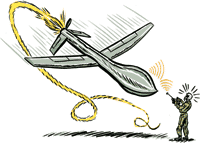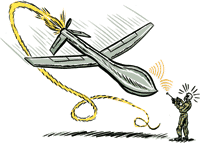
Illustration By: <a href="http://lobrow-illustration.com" target="new">Erik T. Johnson / lobrow-illustration.com</a>

“Don’t test, don’t tell” at the Pentagon
For a while, military reformers looked to be winning the battle against costly weapons systems that don’t work. In the 1970s, they scripted a new maxim, “Fly Before You Buy,”
and by the 1980s, they opened a new office in the Pentagon devoted to overseeing weapons testing. But in recent years, the tide has turned; the Pentagon’s own chief weapons tester, Thomas P. Christie,said in March 2004 that major weapons manufacturers are “learning faster how to avoid testing than we are learning to do it better.” And with each missed test, the public foots the bill for weapons that may place soldiers in unnecessary peril.
|
SYSTEM |
COST |
TESTING |
RESULTS |
|
Stryker Armored Vehicle |
$8.7 billion |
After purchasing hundreds of these personnel carriers in 2000, the Pentagon discovered that the Stryker’s armor did not protect against rocket-propelled grenades—one of the biggest threats to soldiers in Iraq. |
The Army added a 5,000-pound cage around each vehicle, making them top-heavy and obstructing some escape hatches, according to a Pentagon report written after three soldiers aboard Strykers died during a routine Iraq mission. |
|
Hercules C-130J Transport Plane |
About $4 billion |
The Air Force purchased the C-130J as a commercial, off-the-shelf airplane, even though it was the first of its kind, which meant… no need for much testing. |
Pentagon auditors say the planes “cannot perform” intended missions, such as low-altitude night flying; 168 problems with the craft have been reported, many serious enough to cause crashes. |
|
Predator Unmanned Aerial Vehicle |
$641 million through 2002 |
Pentagon testers declared the drone “not operational, effective or suitable” in September 2001. |
So far nearly half of the 48 Predators deployed have crashed. |
|
F/A-22 Raptor |
$28.7 billion since 1986 |
Though the Air Force has spent billions to develop this fighter plane since the mid-’80s, official testing began only last year, exposing problems such as electronics that inexplicably shut down. |
The Pentagon is ignoring calls for additional testing from congressional auditors, who noted in a recent report that it is not even clear “why this aircraft is needed.” |












